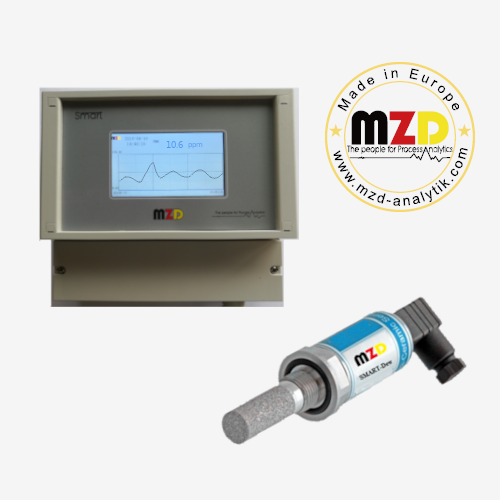
SMART-DT dew pointmeter in monitoring and control of compressed air
Many manufacturing processes require a continuous supply of compressed air. Compressed air is used for many different purposes, such as the actuation and control of pneumatic valves, cylinders, and controllers; to power pneumatic tools in plants; to power mechanical equipment; as a transport medium for powdered bulk materials; or as purge air.
Compressed air always contains some moisture, which, if left unchecked, can cause damage to processes, pneumatic controls, tools, finished products, and even components of the air distribution system itself.
To reduce the occurrence of these problems, it is often necessary to significantly reduce moisture before compressed air is supplied.
A freeze dryer is often used to reduce the moisture content of compressed air. In principle, the compressed air is cooled in a heat exchanger to temperatures above freezing, causing most of the moisture in the air to condense into liquid water, which is then discharged. Efficient operation of the dryer depends on good temperature control in the heat exchanger meter to maintain close to 0°C and the design of the heat exchanger itself. If the temperature drops below 0°C, ice will form on the inner surface and the performance of the dryer will be reduced. Freeze drying machines are often equipped with temperature sensors to monitor the temperature of the outlet air. The temperature measurement is the first indicator of the moisture content of the compressed air, but does not guarantee the quality of the air at the dryer outlet. Measuring the moisture content of the outlet air using a suitable dew point meter is the only correct way to determine if this dryer is working properly.
Regenerative dryer tower dryers can provide a very efficient method of drying air. These dryers are usually configured with dual towers, where while one tower dries the air, the desiccant is regenerated in the other tower. There are usually two types of regeneration - pressure backwash and thermal regeneration. Pressure backwash dryers allow the regeneration tower pressure to drop abruptly to evaporate the moisture, which is then backblown through the compressed air to flush the moisture from the tower to the atmosphere. Thermal regeneration dryers typically regenerate desiccant using high power electric heaters or steam heaters, where energy efficiency is paramount. Dryer requirements may vary, and the drying cycle is usually controlled according to the needs of the dryer output performance, not just a fixed time cycle. The outlet moisture content of the dryer is monitored using a dew point meter, which not only allows quantitative measurement, but also allows the dryer cycle to be controlled by a predetermined moisture content. This method of operation is commonly referred to as a "dew point demand system" and provides the user with significant energy savings and reliable, consistent quality dry air.
Portable dew point meters are often used for air quality testing where there are multiple points of use or long air lines from the compressor to the job site. In-line measurement using a dew point transmitter or a dew point meter with display depends on whether the user is sending a dew point signal to a data acquisition system or simply needs a local display of the measured dew point value. Dew point transmitters are increasingly used for such applications, are easy to install, relatively low cost and provide a range of industry standard output signals suitable for controlling air dryer functions.
Depending on the actual choice of measurement at operating pressure or at atmospheric pressure. Typically the in-line dew point meter is installed behind a filter and measures the dry air after it has passed through the desiccant. Correct installation of the meter and pressure reducer position will facilitate measurement at operating pressure or at atmospheric pressure. A flow meter with the proper range is installed behind the sensor to indicate the flow rate through the sensor.
The sampling device for portable dew point meters is the same and MZD can provide portable dew point meters offering off-the-shelf solutions. A good sampling unit is very important in the measurement. Sampling tubes are preferably made of good quality stainless steel (internal polished tubes) with 3 mm or 6 mm outer diameter and fittings. If flexible connections are required, thick-walled PTFE tubing must be used. The length of the sampling tube should be as short as possible to ensure a fast response, and there should be a tail pipe after the sensor to ensure that the surrounding air does not diffuse backwards in total and affect the measurement. A filter is recommended for compressed air.
MZD SMART-DT dew point meter provides an ideal solution for continuous online measurement or an easy to use portable measurement solution.
